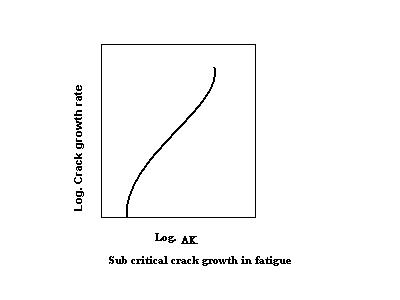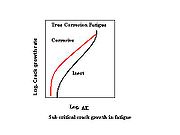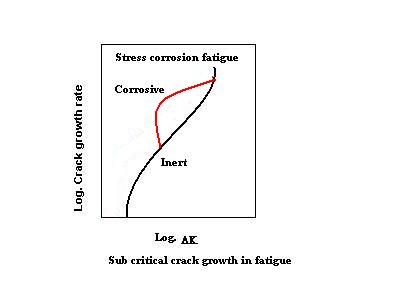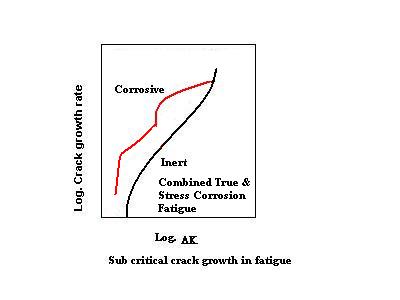
Corrosion fatigue
Encyclopedia
Corrosion fatigue is fatigue
in a corrosive environment. It is the mechanical degradation of a material under the joint action of corrosion
and cyclic loading. Nearly all engineering structures experience some form of alternating stress, and are exposed to harmful environments during their service life. The environment plays a significant role in the fatigue of high-strength structural materials like steel, aluminum alloys and titanium alloys. Materials with high specific strength
are being developed to meet the requirements of advancing technology. However,their usefulness depends to a large extent on the extent to which they resist corrosion fatigue. The effects of corrosive environments on the fatigue behavior of metals were studied as early as 1930. The phenomenon should not be confused with stress corrosion cracking
, where corrosion (such as pitting) leads to the development of brittle cracks, growth and failure. The only requirement for corrosion fatigue is that the sample be under tensile stress.
ing. Such high-strength materials generally exhibit higher fatigue limits, and can be used at higher service stress levels even under fatigue loading. However, the presence of a corrosive environment during fatigue loading eliminates this stress advantage, since the fatigue limit becomes almost insensitive to the strength level for a particular group of alloys. This effect is schematically shown for several steels in the diagram on the left, which illustrates the debilitating effect of a corrosive environment on the functionality of high-strength materials under fatigue.
 Corrosion fatigue in aqueous media is an electrochemical behavior. Fracture
Corrosion fatigue in aqueous media is an electrochemical behavior. Fracture
s are initiated either by pitting or persistent slip bands. Corrosion fatigue may be reduced by alloy additions, inhibition and cathodic protection, all of which reduce pitting. Since corrosion-fatigue cracks initiate at a metal's surface, surface treatments like plating, cladding, nitriding and shot peening
were found to improve the materials' resistance to this phenomenon.
and only the remaining 10 percent in crack propagation. However, in corrosion fatigue crack nucleation is facilitated by corrosion; typically, about 10 percent of life is sufficient for this stage. The rest (90 percent) of life is spent in crack propagation. Thus, it is more useful to evaluate crack-propagation behavior during corrosion fatigue. Fracture mechanics
uses pre-cracked specimens, effectively measuring crack-propagation behavior. For this reason, emphasis is given to crack-propagation velocity measurements (using fracture mechanics) to study corrosion fatigue. Since fatigue crack grows in a stable fashion below the critical stress-intensity factor for fracture (fracture toughness), the process is called sub-critical crack growth. The diagram on the right shows typical fatigue-crack-growth behavior.
 In this log-log plot, the crack-propagation velocity is plotted against the applied stress-intensity range. Generally there is a threshold stress-intensity range, below which crack-propagation velocity is insignificant. Three stages may be visualized in this plot. Near the threshold, crack-propagation velocity increases with increasing stress-intensity range. In the second region, the curve is nearly linear and follows Paris' law
In this log-log plot, the crack-propagation velocity is plotted against the applied stress-intensity range. Generally there is a threshold stress-intensity range, below which crack-propagation velocity is insignificant. Three stages may be visualized in this plot. Near the threshold, crack-propagation velocity increases with increasing stress-intensity range. In the second region, the curve is nearly linear and follows Paris' law
(6); in the third region crack-propagation velocity increases rapidly, with the stress-intensity range leading to fracture at the fracture-toughness value. Crack propagation under corrosion fatigue may be classified as a) true corrosion fatigue, b) stress corrosion fatigue or c) a combination of true, stress and corrosion fatigue.
 In true corrosion fatigue, the fatigue-crack-growth rate is enhanced by corrosion; this effect is seen in all three regions of the fatigue-crack growth-rate diagram. The diagram on the left is a schematic of crack-growth rate under true corrosion fatigue; the curve shifts to a lower stress-intensity-factor range in the corrosive environment. The threshold is lower (and the crack-growth velocities higher) at all stress-intensity factors. Specimen fracture occurs when the stress-intensity-factor range is equal to the applicable threshold-stress-intensity factor for stress-corrosion cracking. When attempting to analyze the effects of corrosion fatigue on crack growth in a particular, both corrosion type and fatigue load levels affect crack growth in varying degrees. Common types of corrosion include filiform
In true corrosion fatigue, the fatigue-crack-growth rate is enhanced by corrosion; this effect is seen in all three regions of the fatigue-crack growth-rate diagram. The diagram on the left is a schematic of crack-growth rate under true corrosion fatigue; the curve shifts to a lower stress-intensity-factor range in the corrosive environment. The threshold is lower (and the crack-growth velocities higher) at all stress-intensity factors. Specimen fracture occurs when the stress-intensity-factor range is equal to the applicable threshold-stress-intensity factor for stress-corrosion cracking. When attempting to analyze the effects of corrosion fatigue on crack growth in a particular, both corrosion type and fatigue load levels affect crack growth in varying degrees. Common types of corrosion include filiform
, pitting
, exfoliation, intergranular; each will affect crack growth in a particular material in a distinct way. For instance, pitting will often be the most damaging type of corrosion, degrading a material's performance (by increasing the crack-growth rate) more than any other kind of corrosion; even pits of the order of a material's grain size
may substantially degrade a material. The degree to which corrosion affects crack-growth rates also depends on fatigue-load levels; for instance, corrosion can cause a greater increase in crack-growth rates at a low loads than it does at a high load.

, additional crack growth (the red line) occurs due to SCC. The lower stress-intensity regions are not affected, and the threshold stress-intensity range for fatigue-crack propagation is unchanged in the corrosive environment. In the most-general case, corrosion-fatigue crack growth may exhibit both of the above effects; crack-growth behavior is represented in the schematic on the left.

Fatigue (material)
'In materials science, fatigue is the progressive and localized structural damage that occurs when a material is subjected to cyclic loading. The nominal maximum stress values are less than the ultimate tensile stress limit, and may be below the yield stress limit of the material.Fatigue occurs...
in a corrosive environment. It is the mechanical degradation of a material under the joint action of corrosion
Corrosion
Corrosion is the disintegration of an engineered material into its constituent atoms due to chemical reactions with its surroundings. In the most common use of the word, this means electrochemical oxidation of metals in reaction with an oxidant such as oxygen...
and cyclic loading. Nearly all engineering structures experience some form of alternating stress, and are exposed to harmful environments during their service life. The environment plays a significant role in the fatigue of high-strength structural materials like steel, aluminum alloys and titanium alloys. Materials with high specific strength
Specific strength
The specific strength is a material's strength divided by its density. It is also known as the strength-to-weight ratio or strength/weight ratio. In fiber or textile applications, tenacity is the usual measure of specific strength...
are being developed to meet the requirements of advancing technology. However,their usefulness depends to a large extent on the extent to which they resist corrosion fatigue. The effects of corrosive environments on the fatigue behavior of metals were studied as early as 1930. The phenomenon should not be confused with stress corrosion cracking
Stress corrosion cracking
Stress corrosion cracking is the unexpected sudden failure of normally ductile metals subjected to a tensile stress in a corrosive environment, especially at elevated temperature in the case of metals. SCC is highly chemically specific in that certain alloys are likely to undergo SCC only when...
, where corrosion (such as pitting) leads to the development of brittle cracks, growth and failure. The only requirement for corrosion fatigue is that the sample be under tensile stress.
Effect of corrosion on S-N diagram
The effect of corrosion on a smooth-specimen S-N diagram is shown schematically on the right. Curve A shows the fatigue behavior of a material tested in air. A fatigue threshold (or limit) is seen in curve A, corresponding to the horizontal part of the curve. Curves B and C represent the fatigue behavior of the same material in two corrosive environments. In curve B, the fatigue failure at high stress levels is retarded, and the fatigue limit is eliminated. In curve C, the whole curve is shifted to the left; this indicates a general lowering in fatigue strength, accelerated initiation at higher stresses and elimination of the fatigue limit. To meet the needs of advancing technology, higher-strength materials are developed through heat treatment or alloyAlloy
An alloy is a mixture or metallic solid solution composed of two or more elements. Complete solid solution alloys give single solid phase microstructure, while partial solutions give two or more phases that may or may not be homogeneous in distribution, depending on thermal history...
ing. Such high-strength materials generally exhibit higher fatigue limits, and can be used at higher service stress levels even under fatigue loading. However, the presence of a corrosive environment during fatigue loading eliminates this stress advantage, since the fatigue limit becomes almost insensitive to the strength level for a particular group of alloys. This effect is schematically shown for several steels in the diagram on the left, which illustrates the debilitating effect of a corrosive environment on the functionality of high-strength materials under fatigue.

Fracture
A fracture is the separation of an object or material into two, or more, pieces under the action of stress.The word fracture is often applied to bones of living creatures , or to crystals or crystalline materials, such as gemstones or metal...
s are initiated either by pitting or persistent slip bands. Corrosion fatigue may be reduced by alloy additions, inhibition and cathodic protection, all of which reduce pitting. Since corrosion-fatigue cracks initiate at a metal's surface, surface treatments like plating, cladding, nitriding and shot peening
Shot peening
Shot peening is a cold working process used to produce a compressive residual stress layer and modify mechanical properties of metals. It entails impacting a surface with shot with force sufficient to create plastic deformation...
were found to improve the materials' resistance to this phenomenon.
Crack-propagation studies in corrosion fatigue
In normal fatigue-testing of smooth specimens, about 90 percent is spent in crack nucleationNucleation
Nucleation is the extremely localized budding of a distinct thermodynamic phase. Some examples of phases that may form by way of nucleation in liquids are gaseous bubbles, crystals or glassy regions. Creation of liquid droplets in saturated vapor is also characterized by nucleation...
and only the remaining 10 percent in crack propagation. However, in corrosion fatigue crack nucleation is facilitated by corrosion; typically, about 10 percent of life is sufficient for this stage. The rest (90 percent) of life is spent in crack propagation. Thus, it is more useful to evaluate crack-propagation behavior during corrosion fatigue. Fracture mechanics
Fracture mechanics
Fracture mechanics is the field of mechanics concerned with the study of the propagation of cracks in materials. It uses methods of analytical solid mechanics to calculate the driving force on a crack and those of experimental solid mechanics to characterize the material's resistance to fracture.In...
uses pre-cracked specimens, effectively measuring crack-propagation behavior. For this reason, emphasis is given to crack-propagation velocity measurements (using fracture mechanics) to study corrosion fatigue. Since fatigue crack grows in a stable fashion below the critical stress-intensity factor for fracture (fracture toughness), the process is called sub-critical crack growth. The diagram on the right shows typical fatigue-crack-growth behavior.

Paris' law
Paris' law relates the stress intensity factor range to sub-critical crack growth under a fatigue stress regime. As such, it is the most popular fatigue crack growth model used in materials science and fracture mechanics...
(6); in the third region crack-propagation velocity increases rapidly, with the stress-intensity range leading to fracture at the fracture-toughness value. Crack propagation under corrosion fatigue may be classified as a) true corrosion fatigue, b) stress corrosion fatigue or c) a combination of true, stress and corrosion fatigue.
True corrosion fatigue

Crevice corrosion
Crevice corrosion refers to corrosion occurring in confined spaces to which the access of the working fluid from the environment is limited. These spaces are generally called crevices...
, pitting
Pitting corrosion
Pitting corrosion, or pitting, is a form of extremely localized corrosion that leads to the creation of small holes in the metal. The driving power for pitting corrosion is the depassivation of a small area, which becomes anodic while an unknown but potentially vast area becomes cathodic, leading...
, exfoliation, intergranular; each will affect crack growth in a particular material in a distinct way. For instance, pitting will often be the most damaging type of corrosion, degrading a material's performance (by increasing the crack-growth rate) more than any other kind of corrosion; even pits of the order of a material's grain size
Particle size (grain size)
Particle size, also called grain size, refers to the diameter of individual grains of sediment, or the lithified particles in clastic rocks. The term may also be applied to other granular materials. This is different from the crystallite size, which is the size of a single crystal inside the...
may substantially degrade a material. The degree to which corrosion affects crack-growth rates also depends on fatigue-load levels; for instance, corrosion can cause a greater increase in crack-growth rates at a low loads than it does at a high load.

Stress-corrosion fatigue
In materials where the maximum applied-stress-intensity factor exceeds the stress-corrosion cracking-threshold value, stress corrosion adds to crack-growth velocity. This is shown in the schematic on the right. In a corrosive environment, the crack grows due to cyclic loading at a lower stress-intensity range; above the threshold stress intensity for stress corrosion crackingStress corrosion cracking
Stress corrosion cracking is the unexpected sudden failure of normally ductile metals subjected to a tensile stress in a corrosive environment, especially at elevated temperature in the case of metals. SCC is highly chemically specific in that certain alloys are likely to undergo SCC only when...
, additional crack growth (the red line) occurs due to SCC. The lower stress-intensity regions are not affected, and the threshold stress-intensity range for fatigue-crack propagation is unchanged in the corrosive environment. In the most-general case, corrosion-fatigue crack growth may exhibit both of the above effects; crack-growth behavior is represented in the schematic on the left.


